
Right-wing Israelis burn a Palestinian flag and shout racist slogans during an anti-Palestinian protest at the Gush Etzion junction, next to the Palestinian town of Bethlehem, following the disappearance of three Israeli teenagers four days earlier: photo by Oren Ziv / ActiveStills, 16 June 2014
Israel
has launched more than 1,300 air strikes since its offensive
began, and Palestinian militants have launched more than 800 rockets at
Israel, the Israeli military has said. Gaza's health ministry said 166
Palestinians had been killed. There have been no Israeli fatalities.
-- The Guardian, 13 July 2014
Ilan Pappe: Israel’s incremental genocide in the Gaza ghetto
Israel’s present assault on Gaza alas indicates that this policy continues unabated. The term is important since it appropriately locates Israel’s barbaric action -- then and now -- within a wider historical context.
This context should be insisted upon, since the Israeli propaganda machine attempts again and again to narrate its policies as out of context and turns the pretext it found for every new wave of destruction into the main justification for another spree of indiscriminate slaughter in the killing fields of Palestine.

Medics bring a young girl injured in an Israeli strike to a Gaza City hospital: photo by Yasser Qudih / APA Images, 8 July 2014
The context
The Zionist strategy of branding its brutal policies as an ad hoc response to this or that Palestinian action is as old as the Zionist presence in Palestine itself. It was used repeatedly as a justification for implementing the Zionist vision of a future Palestine that has in it very few, if any, native Palestinians.The means for achieving this goal changed with the years, but the formula has remained the same: whatever the Zionist vision of a Jewish State might be, it can only materialize without any significant number of Palestinians in it. And nowadays the vision is of an Israel stretching over almost the whole of historic Palestine where millions of Palestinians still live.
The present genocidal wave has, like all the previous ones, also a more immediate background. It has been born out of an attempt to foil the Palestinian decision to form a unity government that even the United States could not object to.

Palestinians search for survivors in the remains of a family home which was destroyed by an Israeli air strike in Gaza City: photo by APA Images/REX, 13 July 2014
Ever since June 1967, Israel has searched for a way to keep the territories it occupied that year without incorporating their indigenous Palestinian population into its rights-bearing citizenry. All the while it participated in a “peace process” charade to cover up or buy time for its unilateral colonization policies on the ground.
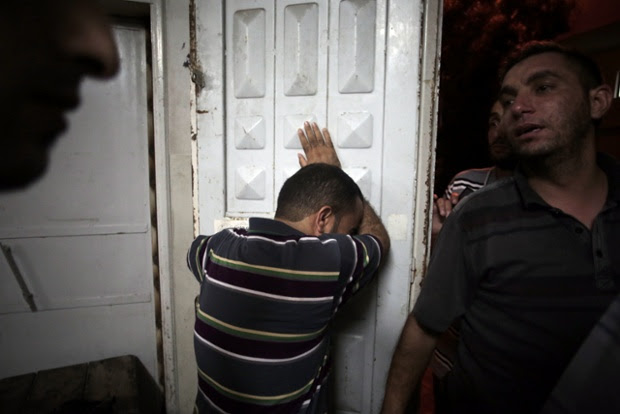
Palestinians mourn in the morgue of Shifa hospital in Gaza City: photo by Khalil Hamra/AP, 13 July 2014
The geopolitical location of the West Bank creates the impression in Israel, at least, that it is possible to achieve this without anticipating a third uprising or too much international condemnation.

A youth examines damage to a centre for disabled people, caused by an Israeli air strike: photo by REX, 13 July 2014
The Gaza Strip, due to its unique geopolitical location, did not lend itself that easily to such a strategy. Ever since 1994, and even more so when Ariel Sharon came to power as prime minister in the early 2000s, the strategy has been to ghettoize Gaza and somehow hope that the people there -- 1.8 million as of today -- would be dropped into eternal oblivion.

People search for their belongings in the rubble of a house destroyed in the northern Gaza Strip: photo by Mohammed Salem/Reuters, 10 July 2012

In Gaza, the implementation of the Zionist vision takes its most inhuman form: photo by Ezz Zanoun / APA Images, 13 July 2014
On 15 May, Israeli forces killed two Palestinian youths in the West Bank town of Beitunia, their cold-blooded slayings by a sniper’s bullet captured on video. Their names -- Nadim Nuwara and Muhammad Abu al-Thahir -- were added to a long list of such killings in recent months and years.
The killing of three Israeli teenagers, two of them minors, abducted in the occupied West Bank in June, was perhaps in reprisal for killings of Palestinian children. But for all the depredations of the oppressive occupation, it provided the pretext first and foremost for destroying the delicate unity in the West Bank but also for the implementation of the old dream of wiping out Hamas from Gaza so that the Ghetto could be quiet again.
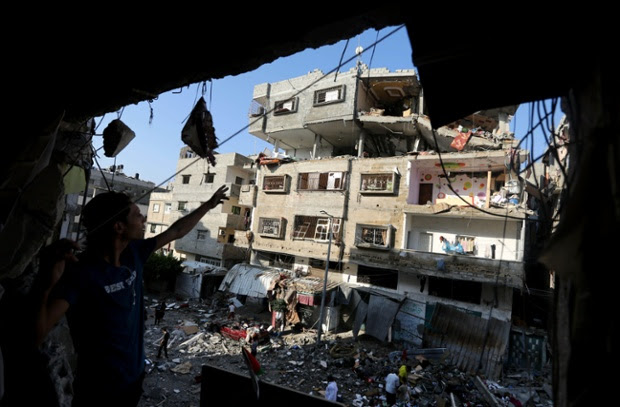
Palestinians inspect the rubble of a house after it was hit by an Israeli missile strike in Gaza City: photo by Hatem Moussa/AP, 10 July 2012
Since 1994, even before the rise of Hamas to power in the Gaza Strip, the very particular geopolitical location of the Strip made it clear that any collective punitive action, such as the one inflicted now, could only be an operation of massive killings and destruction. In other words, of a continued genocide.
This recognition never inhibited the generals who give the orders to bomb the people from the air, the sea and the ground. Downsizing the number of Palestinians all over historic Palestine is still the Zionist vision. In Gaza, its implementation takes its most inhuman form.
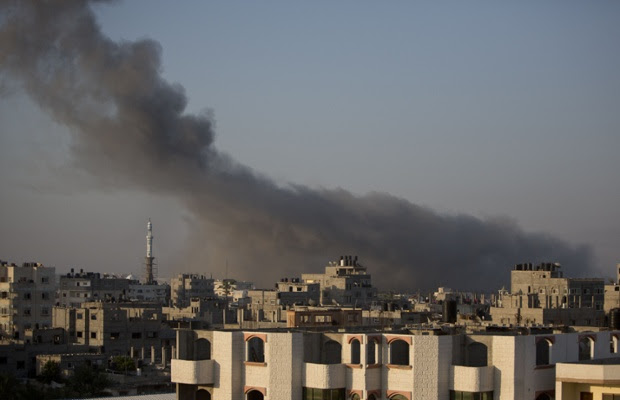
Smoke billows from buildings in Gaza City: photo by Mahmud Hams/AFP, 10 July 2012

Palestinians stand on the rubble of a house in Gaza City: photo by Hatem Moussa/AP, 10 July 2012
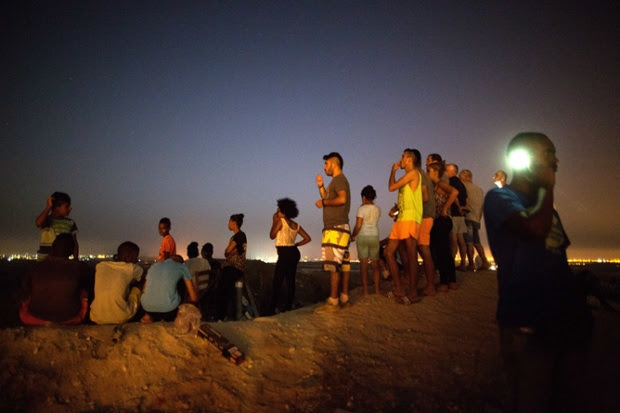
Israelis watch the fighting between the Israeli army and Palestinian militants from a hill overlooking the Gaza Strip: photo by Menahem Kahana/AFP, 13 July 2014

Palestinians gather around the remains of a car hit by an airstrike in Gaza City: photo by Ahmed Zakot/Reuters, 10 July 2012
The media is loyally recruited, showing no pictures of the human catastrophe Israel has wreaked and informing its public that this time, “the world understands us and is behind us.”
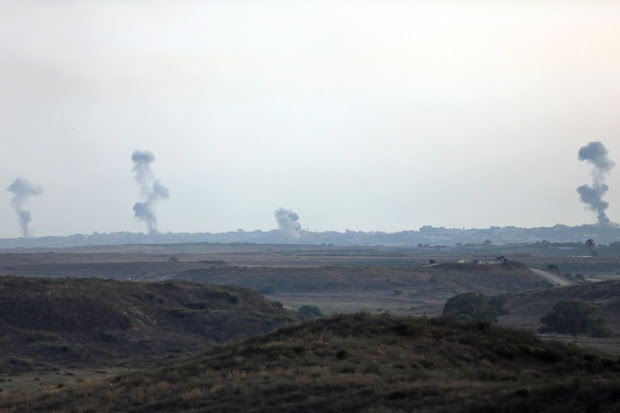
Smoke rises after Israeli strikes on Gaza, seen from the Israel-Gaza border: photo by Lefteris Pitarakis/AP, 13 July 2014
That statement is valid to a point as the political elites in the West continue to provide the old immunity to the “Jewish state.” However, the media have not provided Israel with quite the level of legitimacy it was seeking for its criminal policies.
Obvious exceptions have included French media, especially France 24 and the BBC, that continue to shamefully parrot Israeli propaganda.
This is not surprising, since pro-Israel lobby groups continue to work tirelessly to press Israel’s case in France and the rest of Europe as they do in the United States.

Onlookers stand near a destroyed building and vehicles in Gaza City: photo by Mohammed Abed/AFP, 10 July 2012
The way forward
Whether it is burning alive a Palestinian youth from Jerusalem, or the fatal shooting of two others, just for the fun of it in Beitunia, or slaying whole families in Gaza, these are all acts that can only be perpetrated if the victim is dehumanized.I will concede that all over the Middle East there are now horrific cases where dehumanization has reaped unimaginable horrors as it does in Gaza today. But there is one crucial difference between these cases and the Israeli brutality: the former are condemned as barbarous and inhuman worldwide, while those committed by Israel are still publicly licensed and approved by the president of the United States, the leaders of the EU and Israel’s other friends in the world.
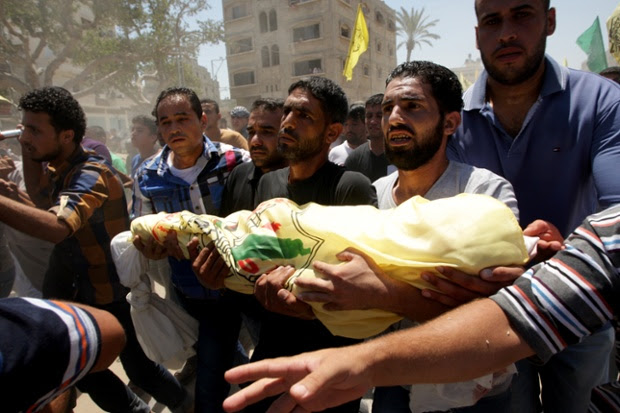
Relatives and friends of the al-Kaware family carry one of the bodies to the mosque during their funeral in Khan Yunis: photo by Abed Khatib/Pacific Press/Barcroft India, 10 July 2012
Those who commit atrocities in the Arab world against oppressed minorities and helpless communities, as well as the Israelis who commit these crimes against the Palestinian people, should all be judged by the same moral and ethical standards. They are all war criminals, though in the case of Palestine they have been at work longer than anyone else.

Israeli soldiers fire a shell towards Gaza: photo by Imago/Barcroft Media, 13 July 2014

A member of the civil defence reacts after an airstrike on a house in Gaza: photo by Ahmed Zakot/Reuters, 10 July 2012
A world that would stop employing double standards in its dealings with Israel is a world that could be far more effective in its response to war crimes elsewhere in the world.
Cessation of the incremental genocide in Gaza and the restitution of the basic human and civil rights of Palestinians wherever they are, including the right of return, is the only way to open a new vista for a productive international intervention in the Middle East as a whole.
Ilan Pappe: Israel’s incremental genocide in the Gaza ghetto, via Electronic Intifada, 13 July 2014
The author of numerous books, Ilan Pappe is professor of history
and director of the European Centre for Palestine Studies at the
University of Exeter
Dr. Mona El-Farra: Two Things
The number of the injured has reached 659 up to this minute, the number keeps increasing. The number of killed is 105. At least forty are women and children. Hospitals are working under great pressure because of a severe shortage of medication and supplies, especially the emergency needs for the operating theaters. And of course the problem of the electricity continues. We don’t have power. We don’t have internet and power most of the time. A feeling of insecurity is the case. No place is safe.
I’d like to share something with you -- two things. First thing, on a personal level, I have had to leave my apartment because all the windows were shattered, and my place is just in front of the sea and it was very very unsafe. I was too close to the bombardment. So I moved to a friend’s house to see if it was safer than our place. No place is safe. This is one thing.
Today, in Gaza, the drones are still in the sky, the jet fighters are still in the sky, gunboats or warships are still hitting Gaza with missiles. The streets of Gaza are really empty -- people are afraid to leave their homes because of the intensity of the shelling. Hundreds of thousands of children are in their homes, terrified, tired, skittish, anxious, clinging to their parents because they are afraid of the shelling. And as you know, we don’t have shelters in Gaza, so just people are trying to be in their homes, trying to be in the safest place inside their homes. This is one thing.
Another thing -- Israel has destroyed more than 210 homes until this minute and the number is increasing. And they give very short notice -- just ten minutes to the family to leave their home. Those ten minutes and then no home -- no memories, no history, nothing. Just get out of the house even without any papers, documents to see who you are, any official documents.
Dr. Mona El-Farra, leader of the Palestinian Red Crescent Society and director of Gaza projects with the Middle East Children’s Alliance, in Gaza City, 11 July 2014

A Palestinian man inspects his Gaza City house which witnesses said was damaged in an Israeli air strike: photo by Ashraf Amra / APA images, 16 June 2014

Palestinian children in a bedroom ransacked by Israeli forces who invaded their family’s home in Salem village east of the West Bank city of Nablus: photo by Nedal Eshtayah / APA images, 21 June 2014
Thousands flee Gaza homes after Israeli warning of large-scale bombing
Israel to hit Beit Lahia area, home to at least 100,000 people, targeting what it says are rocket-launching sites
Thousands of Gazans fled their homes in two northern areas of the coastal strip on Sunday after Israel warned that it would "strike with might" against what it says are rocket-launching sites.
The exodus from Beit Lahia and Attatra came after Israel dropped leaflets and sent text messages warning civilians to evacuate northern Gaza by midday on Sunday in advance of a large-scale bombing campaign. The area is home to at least 100,000 people.
A senior Israeli military officer, in a telephone briefing with foreign reporters, said Israel would strike the Beit Lahia area from the late evening on Sunday. "The enemy has built rocket infrastructure in between the houses [in Beit Lahia]," the officer said. "He wants to trap me into an attack and into hurting civilians."
The leaflet warned: "Those who fail to comply with the instructions will endanger their lives and the lives of their families. Beware."
As the ultimatum drew near, large numbers raced by in pickup trucks or on donkey carts, waving white flags, with many heading to UN-run schools that were taking in refugees.
"They are sending warning messages," said one resident, Mohammad Abu Halemah. "Once we received the message, we felt scared to stay in our homes. We want to leave."

Palestinian evacuees leave their home in Gaza City to seek shelter at a UN school: photo by Mohammed Abed/AFP, 13 July 2014
Outside one UN school, there were rows of horses tied up by families anxious to protect their animals.
During a visit to Beit Lahia after the deadline had expired, the Guardian saw that most residents, had opted to stay in their homes. Some shops were open and hospitals called for volunteers from medical schools to help treat an expected influx of casualties.
The warning was issued hours after Israeli commandos launched an early morning raid on a beach in the Sudaniya neighbourhood in the north of Gaza City, targeting another rocket-launching site. On Saturday the coastal enclave suffered the bloodiest day of the six-day Israeli assault, with 54 Palestinians reported killed.
There has been speculation that Israel may launch a ground offensive into Gaza, a move likely to sharply increase the number of civilian casualties. So far 166 people have been killed, including 30 children, according to Gaza's health ministry. There have been several Israeli injuries but no fatalities.
In the worst single incident of the conflict so far, at least 17 people were killed and 45 injured when two large Israeli bombs hit a house in the Tuffah neighbourhood of Gaza City where the city's chief of police, Tayseer al-Batsh, was sheltering. Five other people were missing, presumed dead.
Most of the injured were returning home from a mosque when they were caught by shrapnel from the blast.
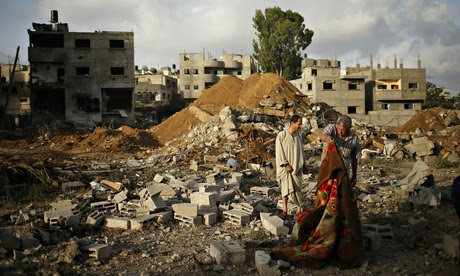
Palestinians stand in the rubble of Tayseer Batsh's family house in Gaza City, which police said was destroyed in an Israeli air strike: photo by Mohammed Salem/Reuters, 13 July 2014
The beach raid by several dozen commandos at 2am on Sunday was the first time Israeli forces have set foot on the ground in Gaza since the beginning of the current campaign. Four commandos were reportedly lightly injured after apparently being spotted approaching and being engaged by waiting Palestinian fighters.
Saad al-Dawla, the night watchman of the al-Mathaf hotel, said he was sleeping when the commandos came to the beach. "I was sleeping in the lobby with a friend. At the beginning we heard shooting from the Palestinian side. I got up and looked out the window and saw that there were people shooting from the water. Almost immediately an [Israeli] helicopter came and started shooting at the water as well," he said. "Later I heard shelling from the sea and the sounded of a warship's siren. The whole thing last about two hours."
Asked whether Hamas or other groups had watchers near the beach, Dawla said he did not know. Ladders at a mosque overlooking the beachfront and leading to its tower strongly suggested that a sentry had been posted there.
Another local resident, who would only give his nickname, Abu Adam, said he was woken by the sound of fighting coming from the beach. "I was lying on the floor with my children. We could hear the sounds of shelling and gunfire and see the windows lit up by the explosions and the flares," he said.
Earlier in the evening two bombs demolished a house belonging to Majid Batsh, a cousin of the Hamas chief of police Tayseer. All that remained of the substantial building on Sunday morning were a few concrete stumps of the pillars that had supported it. A girl aged three was among those killed in the bombing.

A boy mourns after the funeral for relatives of the Gaza police chief Tayseer al-Batsh, who officials said were killed in an Israeli air strike: photo by Mohammed Salem/Reuters, 13 July 2014
"When I got here, I saw destruction everywhere. The bodies were so badly burned I could not recognise anyone. Thirteen of the dead came from my cousin Majid's family. He was just a driver. There are five still missing including a pregnant woman."
On Sunday, Palestinians with foreign passports began leaving Gaza through the Erez border crossing. Israel, which is cooperating in the evacuation, says 800 Palestinians living in Gaza have passports from countries including the UK, US and Australia.
Ahmed Mohana, a US citizen, said he had mixed feelings about leaving friends and family behind in the Gaza Strip. "It is very hard, it is very tough," he said. "We are leaving our family, our relatives and brothers and sisters in this horrible situation we have to do what we have to do."
Israel has launched more than 1,300 air strikes since the offensive began, the military spokesman Lieutenant Colonel Peter Lerner said. Palestinian militants have launched more than 800 rockets at Israel, including 130 in the last 24 hours, the Israeli military.
Israel has said it is acting in self-defence against rockets that have disrupted life across much of the country. It also accuses Hamas of using Gaza's civilians as human shields.
Critics say Israel's heavy bombardment of one of the most densely populated territories in the world is the main factor putting civilians at risk.
Thousands flee Gaza homes after Israeli warning of large-scale bombing: Peter Beaumont in Beit Lahia, The Guardian, 13 July 2014

Relatives of Imad Salem mourn during the fisherman’s funeral in Beit Lahiya in the northern Gaza Strip, 8 June. Salem, 51, died of his injuries that morning two weeks after the Israeli navy fired at him while he was fishing off Gaza’s shores: photo by Ashraf Amra / APA images
Anne Paq: Generations of Palestinian Exile

Al-Amari refugee camp, near Ramallah. A major problem with most refugee camps is the severe overcrowding and lack of infrastructure. There are usually no sidewalks and no green space, only small walkways formed by rows and rows of concrete buildings: photo by Anne Paq, via Electrionic Intifada, 27 June 2014

Israel’s wall in Aida refugee camp near the West Bank city of Bethlehem is built only a few meters away from the homes of the refugees and prevents them from accessing the olive grove where they used to go for recreation: photo by Anne Paq, via Electrionic Intifada, 27 June 2014

Balata camp near the city of Nablus was established in 1950 and has become the largest West Bank camp in terms of inhabitants, with more than 23,000 registered refugees: photo by Anne Paq, via Electrionic Intifada, 27 June 2014

Ahmad, sixteen years old, lives in Aida refugee camp and wants to work as a DJ: “I am proud of being refugee but I hate where I live. I hope to return to my homeland.” His grandmother, 70 years old, says: “I was twelve years old when the soldiers arrived. My house was very beautiful and we grew many things on our land. There were a lot of shootings at the houses. I am a refugee and I got married under the tent, can you imagine? I want to say to the world: do not forget Palestine.": photo by Anne Paq, via Electrionic Intifada, 27 June 2014

Hakma, 75 years old, lives in Dheisheh refugee camp: “I was seventeen years old, I was pregnant and had a two-month-old baby. When we heard about Deir Yassin [a massacre in a village near Jerusalem], we got afraid and left. One day in my original village equals one life in this camp.”: photo by Anne Paq, via Electrionic Intifada, 27 June 2014

Ibrahim, 83 years old, lives in Dheisheh refugee camp near the West Bank city of Bethlehem: “I was around twenty years old and I had a wife and a son. Our family owned 1,000 dunums [a dunum is the equivalent of 1,000 square meters]. We had fifty goats, twenty-five cows, two camels and fifty hens. When the Israeli soldiers entered the Palestinian villages, they shot everywhere and we were afraid. When I heard that my friend and his wife were killed, I became even more afraid and I hid myself and my family in a well for one night. For two years we had been going from one place to another. Once I was able to return to my village, five years after we left. Everything was destroyed, including my home. I just found two dogs that I knew before and they recognized me. I was very sad when I saw all the destruction.”: photo by Anne Paq, via Electrionic Intifada, 27 June 2014

Mohammad, 83 years old, lives in al-Azzeh camp, the smallest in the
West Bank and where the unemployment rate is high. “I cannot explain my
feelings with one sentence,” he says. “Those who have no country have no
dignity. I have no dignity. I always think of the past. Life was better
then. We had our land. Now if you don’t work, you don’t eat. I feel
angry. I was a fighter against the British and the Zionists. If I had
the strength to fight, I will fight the Palestinian leaders.” photo by Anne Paq, via Electrionic Intifada, 27 June 2014

Mahmoud, eighteen years old, lives in Aida refugee camp near Bethlehem. “There is something missing in my life,” he says. Abed, his 75-year-old grandfather, says: “I feel miserable because my village is gone. I was fourteen years old when we had to leave our land. We had a small house and land. It was a simple life but we did not need any help from other people or institutions. I could go back once to Beit Jibrin, and when I saw that everything was destroyed I felt very sad.”: photo by Anne Paq, via Electrionic Intifada, 27 June 2014

Abed, ninety years old, lives in al-Aroub refugee camp: “I used to own a lot of land. I had animals, and trees. I want to go back there to die. I want to finish my life there.”: photo by Anne Paq, via Electrionic Intifada, 27 June 2014
There are more than five million Palestinian refugees
registered with the United Nations, making up the largest group of
refugees in the world. The Palestinian refugee advocacy group BADIL estimates
there are an additional 2.7 million unregistered Palestinian refugees,
making up 66 percent of the Palestinian population worldwide.
They have been waiting more than sixty years to exercise their right to return since their first mass forced displacement with the ethnic cleansing of Palestine by Zionist forces in 1948, what Palestinians call the Nakba or catastrophe, during the establishment of the State of Israel.
Five generations since then, many Palestinian refugees today live in poor conditions in crowded camps. The stateless are among the most vulnerable, as their plight in Syria continues to show.
With the conviction that the right of return is not a side issue but is at the core of the so-called conflict, this series depicts a Palestinian refugee child with a grandparent, a first-generation refugee. Through it I hope to emphasize not only the duration of the plight of Palestinian refugees, but also to visualize the extraordinary bond and solidarity that Palestinian refugees share across generations, preserving their dignity and determination during the long wait and fight for justice.
I first worked on this series in 2008 but I had left it buried and unfinished in my archive. Although I have worked for years in these camps and know how central the issues of Palestinian refugees are, I put it aside as there were always developments in Palestine that seemed more urgent.
This series questions the way the “conflict” is portrayed and how a core issue remains largely left out of the story, leaving the plight of millions of Palestinians in a perpetual state of uncertainty and invisibility.
As the first generation of refugees and the immediate survivors of the Nakba become fewer in number, it is more urgent than ever to bring their histories back to the center of the discourse on Palestine.
Text and photos by Anne Paq, via Electronic Intifada, 27 June 2014

According to the Palestinian Central Bureau of Statistics, 31 percent of Palestinian refugees in the occupied West Bank and Gaza Strip live below the poverty line: photo by Anne Paq, via Electrionic Intifada, 27 June 2014



3 comments:
It's so much easier to look away, or to be reassured by the brainwashing.
The eerie resemblance of the present genocidal Israeli incursion in Gaza to that of 2008-2009 is as impossible to ignore as the past weeks' images of dead, maimed and displaced Palestinians, the majority of them women and children -- who can look at these pictures and then sleep?
Perhaps the most thoughtful analysis of Israeli policy in Gaza as it relates to Israeli military and political strategy in general that I've seen was writ during the 08-09 invasion by Oxford emeritus professor of international relations Avi Shlaim. Avi Shlaim served in the Israeli army and has never questioned the state's legitimacy,
How Israel brought Gaza to the brink of humanitarian catastrophe
They're playing out the terror texts of Torah.
It will be a land without people if this carries on.
Right. No people. But, in the utopian Zionist vision -- "settlers". Once the toxic afterburden of the munitions has been cleaned up. In, say, two or three thousand years.
That whole lovely cliché strategy of "bombing them back to the Stone Age"...
Only thing is, as was learnt in the classic historical template for "asymmetric warfare", Vietnam, somewhere beneath the Stone Age, there are probably going to be... oh no... tunnels.
Post a Comment